|
|
How nature nurtures students
at an inner-city high school.
by Marilyn Berlin Snell
At 16—too young to be so mean—Ashley frequently let her claws fly in class. Scowls appeared at random, over slights no one could recall delivering. Her general disposition often kept the desks around hers vacant while the rest filled with students.
It was January of her junior year at Balboa High School in San Francisco, and the principal had just taken Ashley out of the communication-arts program that would have united her and two disruptive friends in the same classroom until graduation. Only 13 percent of Balboa’s junior class that year scored at or above the national average on the standardized reading and math tests—results that the San Francisco Unified School District called "nothing less than a crisis." Ashley, one impediment to learning that could be easily removed, was placed instead in the two-year environmental-education program. She had no friends there, no interest whatsoever in "tree huggers" or the out-of-doors, and an inclination to punish others for her exile. She’d lost access to her girlfriends, both of whom were also African American, only to find herself in a mix of Filipinos, Samoans, Chinese, an East Indian, a Cambodian, a Guatemalan, a Nicaraguan, a Palestinian, an Anglo, and an African American. Twenty-eight students, all a constant reminder to Ashley of how little she wanted to be where she was.
"I didn’t like it; it wasn’t me at all," says Ashley a year after her forced relocation. "I missed my friends. I didn’t pay attention. I didn’t come to school. And then I got suspended."
When she was readmitted, her exasperated teachers told her that she had to shape up, contribute constructively to class discussions, do her assignments, and come on what remained of the program’s half-dozen annual camping trips. "I thought those trips were going to be a waste of my time," recalls the tall and tawny 17-year-old.
Then she had an encounter with a bear.
It was spring in Yosemite, and Ashley was sharing a tent with Iris and Seka, both Samoan and possessed of contagiously boisterous, in-your-face personalities that could stand up to her own. They weren’t exactly friends, but they got along.
In the middle of the night, Ashley woke to heavy breathing near her head. She froze in her sleeping bag as a very large creature snorted outside the tent. When it passed in front of the screened flap, its furry bulk and outline were unmistakable.
She tried to wake Seka and Iris with loud whispers, fearing that too much noise would provoke an attack. They thought she was up to her old tricks, trying to cause trouble. Seka growled at her to "stop trippin’," leave them alone, and go back to sleep, then took her own advice and rolled over. Ashley remained bug-eyed till the 6:30 wake-up call. When she announced that she’d seen a bear, no one believed her. The teachers were sure she was just acting out. The students had gotten good at ignoring her provocations.
The next night, however, the heavy breather returned with her cub. They were noisy this time, breaking into the bear box and stealing the campers’ food. Others witnessed the rampage and by morning the camp was abuzz. Students commiserated with Ashley about how "hella scary" it had been; teachers apologized for not taking her seriously. It was a turning point. For the first time, she began to feel part of the group.
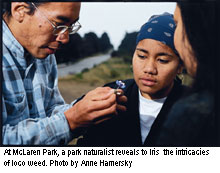 Balboa’s Wilderness Arts and Literacy Collaborative (WALC) is one of thousands of environmental-education programs around the country that take an interdisciplinary, hands-on approach to learning. In WALC (pronounced "walk"), lessons include geology at Mt. Lassen and Joshua Tree National Park; precipitation at Lake Tahoe; and ocean ecosystems at parks and aquariums along the Pacific Coast. Balboa’s Wilderness Arts and Literacy Collaborative (WALC) is one of thousands of environmental-education programs around the country that take an interdisciplinary, hands-on approach to learning. In WALC (pronounced "walk"), lessons include geology at Mt. Lassen and Joshua Tree National Park; precipitation at Lake Tahoe; and ocean ecosystems at parks and aquariums along the Pacific Coast.
Though the Bush administration argues environmental education is "ineffective," the data tell a different story. In four major studies for the State Education and Environment Roundtable (a group of top teachers from 12 state departments of education), researchers found that students in these programs performed better on standardized tests and had fewer discipline problems as well as an increased enthusiasm for learning.
Sounds good, but in the classroom it gets more complicated. The WALC class of 2003 is full of extraordinary youth with problems no different from those of the rest of Balboa: One’s father is in jail, another’s food stamps run low at the end of the month. There are students with woefully below-grade reading and math skills, immigration problems, or trouble doing homework and getting enough sleep because they have jobs every day after school. One student had seen the inside of juvenile court by middle school, for stabbing a classmate in the neck with a pencil.
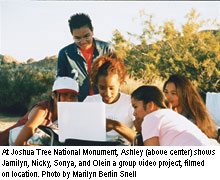 Given these harsh realities, I wondered how camping trips and ecology lessons could make a difference. By scrunching into Balboa’s desk-chairs for lessons and presentations, reading student papers, and hiking California’s wild places with these irrepressible youth over the course of a year, I intended to find out. Given these harsh realities, I wondered how camping trips and ecology lessons could make a difference. By scrunching into Balboa’s desk-chairs for lessons and presentations, reading student papers, and hiking California’s wild places with these irrepressible youth over the course of a year, I intended to find out.
In 1995 WALC began as an after-school "Unity Club" aimed at easing the ethnic rivalries at Balboa. The school, whose student body is drawn from among San Francisco’s three poorest neighborhoods (including Bayview–Hunters Point, where Ashley lives), is 96 percent minority—mostly African American, Asian, Latino, and Filipino. Gangs were active, and tensions were high. U.S. history teacher Conrad Benedicto and literature teacher Ken Gonzalez felt that the students needed a break from city stresses.
Benedicto, 32, and Gonzalez, 29, had come from high schools very similar to Balboa. Gonzalez, a Stanford University graduate, grew up in a rough part of the Bay Area. (He was jumped and had his jaw broken the day before school ended his senior year.) Benedicto, a graduate of the University of California, Santa Cruz, came to the United States from the Philippines at 13, grew up near Balboa, and attended a school he says was even worse. As teachers, they gave their weekends to out-of-town adventures in the wilderness—a decision they say was as much for their own pleasure as for the kids’ benefit. The two were soon joined by science teacher Diana Theriault, 46, born in San Francisco’s Chinatown and graduated from the University of California, Berkeley.
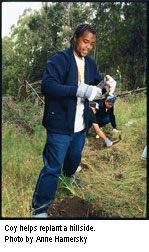 By 2000, when WALC became an official two-year program at Balboa, the three teachers had developed a curriculum that complemented and integrated their camping activities with lessons in American history, literature, and environmental sciences. "If you take ecological principles as your guide, you can’t study things in parts—there’s a disconnect, an imbalance of information that keeps you from understanding the whole," says Benedicto. By 2000, when WALC became an official two-year program at Balboa, the three teachers had developed a curriculum that complemented and integrated their camping activities with lessons in American history, literature, and environmental sciences. "If you take ecological principles as your guide, you can’t study things in parts—there’s a disconnect, an imbalance of information that keeps you from understanding the whole," says Benedicto.
"Our students have also been disconnected from the educational process," Gonzalez adds. "In WALC, they study themselves and people who are like them. They become involved with their education and in that way find their sense of place—on the earth as well as within society and their culture."
In addition to class assignments, WALC students are put in charge of paper recycling at Balboa. (One student calls it "the best direct action" she can take.) The students also spend two days a month at McLaren, the Bay Area’s largest urban park, a short city-bus ride from Balboa. They plant trees, dig diversion ponds, and reseed eroded hillsides, getting their hands dirty in their park’s rich dark soil. "I loved it when the students stopped calling it ‘dirt,’" says Theriault.
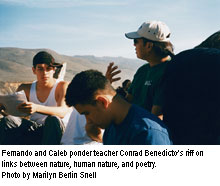 It’s a chilly November morning on the year’s second camping trip. Three rented white vans variously sampling Shakira, Lauryn Hill, and Al Green pull up at the Andrew Molera State Park along Highway 1 for the first stop on a weekend of studying oceans. WALC teachers are also trip drivers, and their iPods play recorded songs in the vans. But no headphones, CD players, or other personal tune-out devices are allowed on the camping trips. It’s a chilly November morning on the year’s second camping trip. Three rented white vans variously sampling Shakira, Lauryn Hill, and Al Green pull up at the Andrew Molera State Park along Highway 1 for the first stop on a weekend of studying oceans. WALC teachers are also trip drivers, and their iPods play recorded songs in the vans. But no headphones, CD players, or other personal tune-out devices are allowed on the camping trips.
Shouts of protest ensue when students realize they have to ford a creek to get to the beach. Ashley keeps her shoes on and tromps forward while everyone else proceeds barefoot. (Later, she will wear brand-new white socks around camp. When I ask her why, she says, "My shoes are wet and I have five pairs of socks so what the heck.") A burly six-foot-three African American named Coy, and Fernando, a Salvadoran, lob rocks close to the girls and do their best to make big splashes. There is laughter and a few pained shrieks.
At the beach a mile later, after two deer in a patch of scrub oak bring the hikers to an awed standstill, the teachers present the day’s lessons. The first is called "Dances With Tides." The students sit in a circle on the mauve-tinted sand. Bettina has been chosen to represent the moon and stands outside the circle. Coy, big and blazing in his yellow Old Navy T-shirt, is the sun. "At low tide, where does the water go?" asks Gonzalez of the group. No one, including me, has a clue.
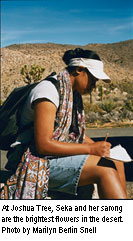
Bettina walks slowly around the circle. We link arms and lean back when she’s directly behind or opposite us. We watch the circle expand and contract, and learn about high and low, neap and spring tides; how the ocean changes shape based on the moon’s gravitational pull. Gonzalez delivers a science lesson, but he’s also using these push/pull forces as a metaphor for the dynamics of life.
"What does this experiment have to do with you?" he asks. Coy, who, as the sun, is still stuck outside the circle in a driftwood pile, cites Ceremony, the book by Leslie Marmon Silko they are reading in Gonzalez’s class. The novel is about being out of balance with oneself, one’s culture, and the land, and the search by Tayo, a Native American and World War II veteran, for a sense of place. Coy recalls how, in Native American cosmology, the universe was created by Spider Woman. "It’s an important myth, this web of life," he says. "When it comes apart we’re all in trouble."
Gonzalez suggests other ways they might be like the water. "You’re influenced by the events, circumstances, and people around you. For all your life, these things have shaped who you are."
A sand flea bites Bettina. She slaps her shin and yells, "Bugs, man. I hate nature."
Two poems by Janice Mirikitani are then passed around. The first, "Prisons of Silence," relates life inside a WWII Japanese internment camp. The second, "Suicide Note," is about an Asian-American student who jumps to her death after not receiving a perfect 4.0 in school. The poems are read aloud by volunteers.
Before they separate to write in their journals, they are told that they will be asked to share their observations—about the forces that shape the earth and those that have shaped them—later around the campfire. Fernando doesn’t understand the assignment, so Benedicto stays and explains as others stroll away, with pen and paper, toward their task.
The students disperse along the rocky beach. Sue, a statuesque Chinese athlete and a bit of a daredevil, scales an outcropping and sits just beyond the breaking waves. Others huddle on or against driftwood with notebooks propped on their knees. They focus, write, look up and around them, daydream, then get back to the page. There is silence, except for the waves and an occasional gull’s screech. The sun’s angle is weak but still warming.
I wander beyond the students while they work. Colorful fall leaves and runnelled kelp litter the wet sand at shoreline. The marine spray—its chill and its hints of life—are transporting. After the lesson on tides I feel a new sense of connection to the sea, since I finally understand the forces behind rising and receding wavelets that now envelop my bare feet.
An hour later, the students rejoin for the hike back to the van. Exhausted and a little cold after a day at the beach, we ride to the campsite in Julia Pfeiffer Burns State Park as the sun is setting. The vans are unloaded, then students group up and begin to erect their accommodations while the teachers start dinner. Ashley yells, "No transgender tents!" for comic effect, but the admonition is unnecessary. Caleb and Jenelyn are the only couple and they rarely even hold hands in front of the others, though they’re always together. They speak to each other in Tagalog, using exotic diminutives. I’m surprised that there’s no messing around on camping trips—they’re teenagers, after all, and I remember my own misbehaving past—until I learn that if students break the rules they are banned from all future trips. In the WALC family, Gonzalez is the strict and grumpy dad, Theriault the no-nonsense mother, and Benedicto the sort-of-cool but responsible older brother. They are the enforcers, and the campers know it.
As the students settle in I hear Tagalog, Samoan, and Spanish wafting from the tents. The loud giggling is definitely Samoan.
When Fernando emerges, he is carrying Babar, a gray elephant with a golden crown between its big ears. The sight is arresting: A guy who looks like a soap opera heartthrob (and is seen as such by many of the females in WALC), clutching a stuffed animal. He’s also wearing oversize red-satin boxing trunks, a sleeveless white undershirt, a gold cross, a beach towel tied around his neck like a cape, and house slippers—in a dense and damp redwood forest. To my amazement no one makes fun, though Iris does shout from her tent to accuse him of wearing a "wife-beater" shirt. When I ask him about the elephant, Fernando—who, in the classroom, never speaks and seems either painfully shy or merely bored—says without embarrassment that he’s had it for 14 years and can’t sleep without it. Fernando has been in WALC since his junior year but this is only his second camping trip (those who miss trips must do extra writing and reading assignments).
Benedicto sits on a picnic table near the struggling fire, playing his guitar. Sue plays Theriault’s guitar next to him, picking up chords and humming along with the tunes, traveling a jagged path from Incubus to "Leaving on a Jet Plane."
Before we eat our soy veggie burgers and salad, Coy reads a Wendell Berry poem, followed by a minute of silence, which is shortly followed by gripes about the rabbit chow and the fact that there’s no meat.
"Hey, remember Fast Food Nation?" challenges one student, in reference to the book they’re reading in Benedicto’s class about the fast-food industry and the horrors of slaughterhouses. "We don’t need to eat that stuff!" Benedicto, who wears his thick black hair in a long ponytail, proudly admits being a vegetarian. "It’s good for you!" he argues. The students groan about his hippie habits but eat their dinner.
Yessika’s family is from Guatemala. She says across the fire at Fernando that she wishes they had pupusas, a Latin American dish that Fernando’s Salvadoran mom apparently makes well. Iris whispers to me that in Samoan pupusa means "ashes."
After the dishes are done, students regroup around the campfire. Babar changes hands. Iris, who usually acts like a tomboy, cradles the elephant in her arms. Yessika, wearing pale-pink flannel pajamas with lip gloss to match, looks incongruously glamorous. She wants Babar but Iris won’t give him up. Everyone gets comfortable. Benedicto asks who wants to begin the sharing.
Sue jumps in. "Crossing that river today was hard and kind of cold. Then walking that mile to the beach was also difficult. But it’s like an allegory for WALC. It’s hard, but you get through it and there’s beauty at the end."
Theriault later tells me she calls Sue her butterfly. "She is one of those bright students who get easily bored and so don’t go in-depth or stay with any one thing very long. She flits from flower to flower." Born to Chinese parents and raised in Australia, Sue has nervous hands on camping trips—fashioning fans out of palm fronds, a strap for her water bottle from reeds. In Big Sur, she makes art pieces from leaves and pine needles without even noticing what she’s doing.
Janet goes next. She’s Palestinian and riffs on the rocks at the beach before she segues into a poem with lines including "Bang, bang, a man is shot/rocks flying back and forth/young men and women fighting for peace/and me/I walk in my home and food is cooking/there are voices of laughter."
Iris says, "Now I know how water moves. That’s cool, man. But about writing poetry? I tried to stretch my heart into a poem but I couldn’t do it."
Nicky’s parents are from Cambodia. She has spiky dyed-orange hair and plays in a band called the Sinopunks. "The suicide poem is something I can really relate to," she begins, recalling lines from Mirikitani’s "Suicide Note" about not being good enough, strong enough, smart enough. "Instead of it off a grade, like in the poem, it’s off my mom and dad. There’s a lot of anger in me. I’m gonna read what I wrote: ‘Rejection has locked me in a cage/cage full of rage/full of anticipation/Will I turn it on myself?/Will I hurt my help?’" She goes on in a hip-hop cadence, the intensity of her feelings crackling like fire.
Ashley seems uncharacteristically emotional as she speaks. "I had a lot of fun on that beach today, even if those poems related to me. I’ve got a lot of pressure on me, from a lot of different people," and then she goes quiet.
Fernando follows. It’s the first time I’ve heard him speak in front of his classmates. "I too kind of relate to that suicide poem," he says in a deep, resonant voice. "I really try and get good grades but I’m not good enough for my mother. I try and be a good person but it’s not appreciated. My family never accepted me. There is always anger and fighting in my house. I’ve felt alone most of my life. Also, I’m sorry it wasn’t until now that I opened up to you guys and tried to get to know you." He chokes up and can’t continue.
Other students talk about their own suicide fantasies, poverty, high anxiety, rage, pressure. Fernando’s are not by a long shot the only tears shed. In the silence after the last student speaks, my throat is tight, the side of my mouth sore from biting back emotion. All I can think of is escaping to my tent; to be near the brook and its soothing, cool rhythms; to lie beneath the stars and the ancient redwoods; to get beyond these stories. I can’t shake thoughts of the students though—their desperate, rushing voices. Sleep comes slowly, and is troubled.
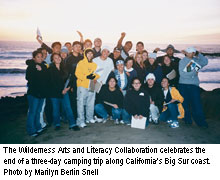
In the morning, students move groggily in the direction of food but once gathered are animated. Toward those who took the greatest risks the night before, made themselves most vulnerable, there is a certain tenderness coming from teachers and students alike.
Benedicto later tells me that he’d had some trepidation as he stood at the copy machine with "Suicide Note" before the trip. He worried, he says, that "discussing the poem would bring out emotions and recall experiences that might be too intense." But, he adds, "I believe—no, I’ve seen—that students are at their best when they’re out in nature. Nature is nurture. That exquisite beach was simply the best place to tackle a life lesson like this."
Throughout the year, students move between life lessons and brass tacks—getting class assignments for individual and group projects that will constitute the bulk of their grades. These projects include a 15-page "manifesto" that imagines and then examines an ideal economic and political system that privileges the environment; a "self-analysis" paper that discusses the values, institutions, and events that have shaped the student’s life; and several group presentations requiring research, teamwork, and the adept use of video and PowerPoint. The first collaborations, which are put on publicly during school lunch periods, occur fall semester.
"WALC has changed my boy," says Coy’s mother, Sandra, a night-shift nurse, after her son’s group offers information on hazardous waste for Theriault’s advanced biology class. Coy’s group, one of six lunchtime presenters, focuses on how toxics find their way into the San Francisco Bay. The theme of the presentations is environmental justice—how race and poverty affect one’s proximity to polluting industry, toxic dumps, and so on. During Ashley’s group presentation, for example, she points out with a hint of anger in her voice that her neighborhood of Hunters Point contains hundreds of toxic sites and accepts the majority of San Francisco’s hazardous waste. "The people treated bad like this are usually poor people of color," she says. "The government denies Hunters Point residents their rights as well as their health."
While some see environmental justice as discrete from mainstream environmentalism, Coy and others break down the false dichotomy. Environmental injustice is the litter, graffiti, and poor services in their neighborhoods. Or it’s the toxics in San Francisco Bay or the industrial farms in the Midwest that pollute the air and water to provide low-cost, low-quality meat to the fast-food joints where they like to eat.
During Coy’s group presentation, the room is full of non-WALC students, drawn mostly by the promise of free pizza after the talk. But Sandra came to see her son. She is one of the few family members to attend any of the WALC presentations. "Coy came back so excited from his first camping trip last year. We have the magnet of Yosemite up on our refrigerator. I’ve never been there. Never even thought about going before. Now I do."
When Coy, hair in braids and pants baggy, comes up to his mother, she smiles at him from her seat and says, "I’m so proud of you, sweetie." He leans down and hugs her quickly with one arm, without looking at her—acting cool and nonchalant—but you can tell he’s pleased with the compliment. She turns to me and adds, "I just sign the slips when he says he’s going on a WALC trip. I worry far less about him being out in nature than I do while he’s at school."
Unfortunately, Coy misses the spring trip a few months later to Joshua Tree National Monument because Sandra has to work extra shifts and he has to take care of his siblings. Other students have conflicts as well—it’s the last trip before graduation and, at five days, the longest trip of the year—so only 14, half the group, end up going.
On the first night in the Cottonwood Campground at the southern end of Joshua Tree, Theriault gives a lesson about the practical and medicinal uses of desert plants. Students are attentive, which I’m secretly thrilled about, since I come from the Sonoran Southwest and have an abiding affection for the desert. When Theriault reveals its secrets, it makes searching for and finding the plants she describes like discovering hidden treasures.
Theriault tells us that the yucca can be used to make soap, and Iris responds, "Good, I forgot my shampoo." We learn that the Cahuilla Indians in the Mojave Desert, where we are, inhaled the vapors from boiling creosote to treat respiratory infections. The fleshy pads of beavertail cactus were used to help heal cuts and wounds. We also learn that the jojoba, or Simmondsia chinensis, helped save the sperm whale, after it was discovered that oil from the plant had properties similar to whale oil and could be used to lubricate high-speed machinery.
On a hike the next day, Fernando has his beach-towel cape on again—it’s become a kind of trip uniform—and a T-shirt beneath his visor, so that he looks like a Latinized cross between Lawrence of Arabia and Superman. He has come out of his shell over the year and now talks enough to drive people crazy. When we stop for lunch, Ashley finds a granite perch with good reverb and begins singing an India.Arie song. Fernando dances with his arms at his chest, in cape and full headdress. When she messes up they start laughing, their echo bouncing down the boulders of Hidden Valley.
I ask Nicky what she thinks of the desert. "It’s crazy, dude. You think there’s nothing here and then you find out all these plants are like a medicine chest." She has a sore throat and when she learns that juniper berries can help soothe the burn she pops one in her mouth. Everyone is excited to discover that the berries can also be used to treat acne.
On another hike, to Mt. Ryan, we stop three-quarters of the way up the steep slope, find rocks to rest on, take in a spectacular view of the Joshua Tree basin, and get a geology lesson from Benedicto on Pinto gneiss and monzogranite. When he talks about how monzo rises up in globules, I can see it in the valley below. We all can. I ask whether it makes a difference to learn about geology out here rather than in class. Ashley looks at me like I’m very dim.
"Yes, of course it does!" she says. "When I learn about something like this in the classroom I really don’t care. What does it matter? I can’t touch it, interact with it. It just doesn’t stick." She later tells me that part of why she was so rowdy in communication arts her junior year was that she was bored. She wasn’t learning anything. "It was all based on technology, and we’d jump from subject to subject without making any connections. In WALC we’re talking about the war in Iraq; we’re talking about what’s happening there–to the people and the land. We argue about it in U.S. history, we learn about it in environmental sciences. It helps me make sense of things because I see it from different angles."
That afternoon, like the rest of the desert’s creatures, we lay low and stay out of the sun. Ashley, Seka, and Sue sit on the shaded concrete picnic platform. They’ve discovered that they can use charcoal from last night’s fire to draw on the concrete. Sue has stopped flitting. She had borrowed Theriault’s book on desert flora the night before and now draws a surrealist version of the plants while describing how mesquite sap was used as an adhesive; ocotillo flowers for a tasty drink; and saguaro fruits for syrup or, if fermented, for wine.
Seka draws what she calls her "island hut," with a thatched roof and intermittent bamboo poles instead of walls. She and her family still visit Samoa. Her drawing reminds me of one of the year’s most poetically dissonant moments, during a WALC winter trip to Washoe County near Lake Tahoe. A family of Washoe, the original inhabitants of the Tahoe area, had just finished singing traditional songs, and telling us about their tribe’s history and customs as well as current efforts to retrieve their language. After some whispering and a retreat to get their sarongs, Seka and Iris performed a traditional Samoan dance in thanks. Benedicto accompanied them on a kagul–a Philippine rhythm instrument he’d brought along. Beyond Iris and Seka’s graceful, swaying movements, through the cabin’s plate-glass window, it was snowing.
Ashley, getting her hands dirty because she keeps erasing lines of charcoal to redraw them, says she’s designing her prom dress. It’s an off-the-shoulder number, black, and very elegant. She says that when she started high school she didn’t think she’d care about going to the senior prom, but admits that now she’s kind of excited.
On the last day in Joshua Tree we are driving back from a hike when something catches my eye out the van window. Iris sits behind me and we both gaze up to see what look like shorebirds (Shorebirds? In the desert?), hundreds of them, in a nebulous silvery formation. When they turn, their bluish white feathers make them invisible for a split second, and then they reappear, flashing brightly above us and moving in an undulating circle reminiscent of that long-ago beach lesson on tides. Iris and I are the only ones to see the incredible dance, and can’t believe this incongruous, fragile–even defiant–presence in such a hostile landscape. (I later learn they are terns migrating through Joshua Tree on their way to the Salton Sea.)
A few weeks later, on her in-class final for Gonzalez, in answer to the question, "What did this year teach you?" Ashley writes: "In this year alone, I have learned and changed more than I have in all my years prior. I have learned how to learn–and listen and respect knowledge even if and when I disagree. I have become a better person (in my opinion) because of this. I am grateful." She continues, "The overall theme for WALC this year was ‘activism.’ Everything we read/worked on/watched was able to be related back to that. I think this was an important theme because–well, we spend all this time talking about injustices and wrongdoing, but so what if you’re not going to do anything about it? That’s the first thing: Become a subject, not an object." She cited as important literary influences The Autobiography of Malcolm X, Fast Food Nation, Ceremony, and Antigone
After their May graduation, nearly all of WALC’s class of 2003–including Coy, Seka, Iris, and Sue–were headed to college. It is a rate no other two-year program at Balboa matched. The one WALC student not college-bound is Fernando, who has merely been delayed. He dropped out of school for a while during sophomore year and so needs a few more credits to be eligible for his diploma. He plans to join his friends at college next year. Ashley was voted prom queen by Balboa’s senior class and will study journalism at City College of San Francisco this fall.
Marilyn Berlin Snell is Sierra’s writer/editor.
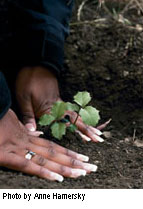 At its inception, Balboa’s Wilderness Arts and Literacy Collaborative received $200,000 in public and private funding for environmental education, including a multiyear grant from the Sierra Club’s Youth in Wilderness Program. With the economic downturn, however, the Sierra Club is unable to continue funding such projects. And with a deficit of $38 billion, the state of California is not likely to pick up the slack. WALC’s future, and those of many programs like it around the country, is in doubt. If you would like to find out how you can help, visit www.walcsf.net. (The Sierra Club has recently launched Inside the Outdoors, www.sierraclub.org/insidetheoutdoors, an effort to secure public funding in California for programs like Balboa’s.) At its inception, Balboa’s Wilderness Arts and Literacy Collaborative received $200,000 in public and private funding for environmental education, including a multiyear grant from the Sierra Club’s Youth in Wilderness Program. With the economic downturn, however, the Sierra Club is unable to continue funding such projects. And with a deficit of $38 billion, the state of California is not likely to pick up the slack. WALC’s future, and those of many programs like it around the country, is in doubt. If you would like to find out how you can help, visit www.walcsf.net. (The Sierra Club has recently launched Inside the Outdoors, www.sierraclub.org/insidetheoutdoors, an effort to secure public funding in California for programs like Balboa’s.)
The Sierra Club still provides low-income inner-city youth in 50 cities with wilderness trips through its Inner City Outings program. For more information on ICO, visit www.sierraclub.org/ico/about.asp. The Sierra Club also offers a national clearinghouse for environmental-education information at www.sierraclub.org/education. |